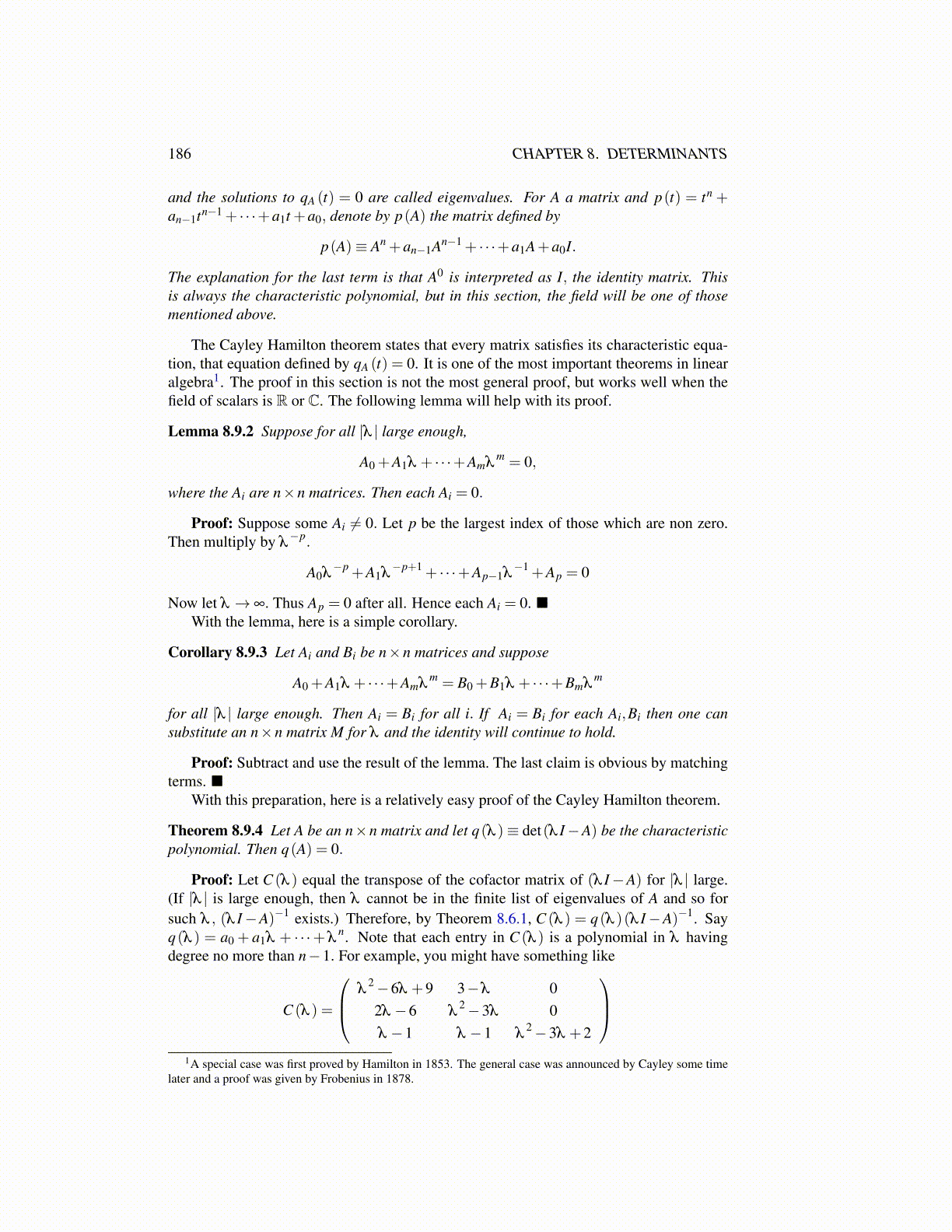
186 CHAPTER 8. DETERMINANTS
and the solutions to qA (t) = 0 are called eigenvalues. For A a matrix and p(t) = tn +an−1tn−1 + · · ·+a1t +a0, denote by p(A) the matrix defined by
p(A)≡ An +an−1An−1 + · · ·+a1A+a0I.
The explanation for the last term is that A0 is interpreted as I, the identity matrix. Thisis always the characteristic polynomial, but in this section, the field will be one of thosementioned above.
The Cayley Hamilton theorem states that every matrix satisfies its characteristic equa-tion, that equation defined by qA (t) = 0. It is one of the most important theorems in linearalgebra1. The proof in this section is not the most general proof, but works well when thefield of scalars is R or C. The following lemma will help with its proof.
Lemma 8.9.2 Suppose for all |λ | large enough,
A0 +A1λ + · · ·+Amλm = 0,
where the Ai are n×n matrices. Then each Ai = 0.
Proof: Suppose some Ai ̸= 0. Let p be the largest index of those which are non zero.Then multiply by λ
−p.
A0λ−p +A1λ
−p+1 + · · ·+Ap−1λ−1 +Ap = 0
Now let λ → ∞. Thus Ap = 0 after all. Hence each Ai = 0. ■With the lemma, here is a simple corollary.
Corollary 8.9.3 Let Ai and Bi be n×n matrices and suppose
A0 +A1λ + · · ·+Amλm = B0 +B1λ + · · ·+Bmλ
m
for all |λ | large enough. Then Ai = Bi for all i. If Ai = Bi for each Ai,Bi then one cansubstitute an n×n matrix M for λ and the identity will continue to hold.
Proof: Subtract and use the result of the lemma. The last claim is obvious by matchingterms. ■
With this preparation, here is a relatively easy proof of the Cayley Hamilton theorem.
Theorem 8.9.4 Let A be an n×n matrix and let q(λ )≡ det(λ I−A) be the characteristicpolynomial. Then q(A) = 0.
Proof: Let C (λ ) equal the transpose of the cofactor matrix of (λ I−A) for |λ | large.(If |λ | is large enough, then λ cannot be in the finite list of eigenvalues of A and so forsuch λ , (λ I−A)−1 exists.) Therefore, by Theorem 8.6.1, C (λ ) = q(λ )(λ I−A)−1. Sayq(λ ) = a0 + a1λ + · · ·+ λ
n. Note that each entry in C (λ ) is a polynomial in λ havingdegree no more than n−1. For example, you might have something like
C (λ ) =
λ2−6λ +9 3−λ 02λ −6 λ
2−3λ 0λ −1 λ −1 λ
2−3λ +2
1A special case was first proved by Hamilton in 1853. The general case was announced by Cayley some time
later and a proof was given by Frobenius in 1878.